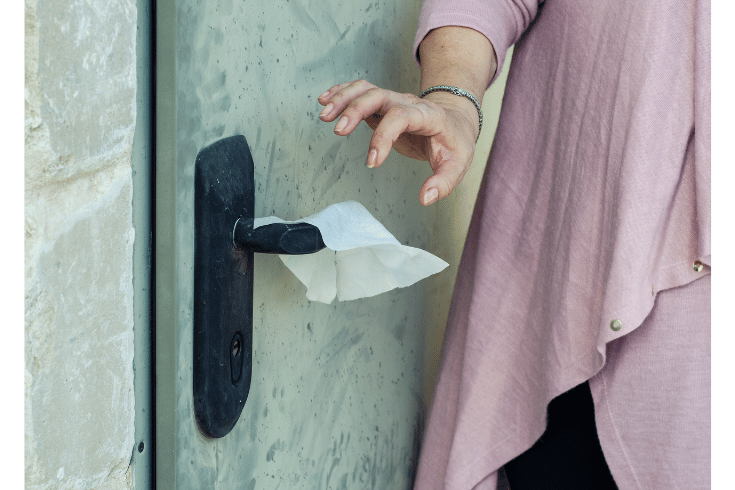Understanding OCD: The Role of Uncertainty and Imagination
Medically reviewed by Dr. Alik Widge, MD, PhD. Dr. Widge is a brain stimulation psychiatrist and biomedical engineer. He is an Associate Professor of Psychiatry at the University of Minnesota, where he directs the Translational NeuroEngineering Lab. He uses multiple advanced methods, including deep brain stimulation and transcranial stimulation, to treat otherwise treatment-resistant OCD and related disorders. In his animal laboratory, he also studies the neurobiological basis of habits and stuck thinking.
Joe knew that the chances he’d contact a deadly germ in the environment were very low. But they weren’t zero.
Erica understood that the chances she’d cause someone she loves to die because she didn’t flip the light switch on and off 124 times was low, but how could she be “100% sure” that that wouldn’t happen?
Michael understood that it’s unlikely that a black hole would open up in front of the Earth and swallow it unless he did his time-consuming pre-bed ritual…but what if it did happen?
All these examples are related to likelihood, risk, uncertainty and it’s an element involved in most OCD experiences.
The Role of Likelihood and Risk in OCD
You may have heard that healing from OCD requires “tolerating uncertainty” and that OCD is closely related to “intolerance of uncertainty”. This emphasis on uncertainty is one of the reasons that OCD is often described as the “doubting disease”, because those of us with OCD doubt what we don’t know “100% for sure”. We doubt what we don’t know “for certain”.
To illustrate this idea concretely, consider one of my primary OCD theme areas: “What if I die of rabies”.
To be specific, my doubts (obsessions) were: “What if I was bit by a rabid bat and didn’t realize I was bit. If I didn’t realize I was bit by a rabid bat, then I won’t go get the rabies vaccine. If I was bit by a rabid bat and I don’t get the vaccine, then, by the time the symptoms of rabies begin to show, it will be too late to obtain treatment and I’m going to die a terrible death.”
As you might imagine, I’d done a lot of research on the chances of dying of rabies. On average, the chance of someone dying of rabies in the United States is about one in 222,200,000 per year.
Those are pretty good odds!
And is it likely that I would be bit by a rabid bat and not realize it? That’s hard to imagine.
But now we’ve struck on the key word: Imagine. And we can link this up with the very precise meaning of “uncertainty” within OCD.
The Power of Imagination in OCD Obsessions
When someone experiencing OCD has an intrusive thought that sounds something like “What if X, Y, Z happens?”, underlying the thought is an image (Note: this image isn’t usually at the forefront of consciousness when having an obsession, but, if we look, it’s usually down there).
Can I imagine an image of me dying of rabies? Of course I can. I can see myself foaming at the mouth in a hospital bed right now. Further, can I imagine an image of me being bit by a rabid bat and not noticing it? Of course I can. I’m having the image in my mind right now.
And when I was compulsively checking an item on the ground to make sure that it wasn’t a bat, could I imagine that what appeared to be a stick was actually a rabid bat that bit me without me knowing? Once again, same answer: Of course. So I’d have to check very closely and take pictures to be “sure”.
How Intrusive Thoughts Operate
What does all of this mean? Intrusive thoughts within OCD operate on a simple but powerful rule: If you can imagine an image of it in your head, it might happen.
It’s because of this rule that those I’ve worked with have been devastated by thoughts like these:
What if I’m struck by a meteorite (Can you imagine a picture of that in your head? I can).
What if I’m abducted by aliens and they do terrible things to me (Can you imagine a picture of that in your head? I can).
What if I’m attacked by zombies (Can you imagine a picture of that in your head? I can).
What if a tall building I’m in randomly collapses (Can you imagine a picture of that in your head? I can).
What if I randomly drive my car into a group of pedestrians next to the road (Can you imagine a picture of that in your head? I can).
What if I inexplicably stab my husband with a knife? (Can you imagine a picture of that in your head? I can.)
What if I get stuck with this “not just right feeling” for the rest of my life and as a result I can’t truly enjoy my life again? (Can you imagine a picture of that in your head? I can.)
What if I get stuck with this thought for the rest of my life and, as a result, I can’t truly enjoy my life again? (Can you imagine a picture of that in your head? I can.)
None of these fears are likely. But all of them can be imagined which means that all of them are possible.
Now, let’s really reinforce how this part of OCD works by considering it from another angle, considering something that you can’t imagine.
I want you to picture a circle in your mind. Got it? Good. Now I want you to let the circle go and picture a square in your mind. Got it? Great.
Now, I want you to imagine a picture of a circle that is also a square at the same time. Can you picture that? Of course not. Because you can’t imagine a circle that is simultaneously also a square. You could imagine a circle transforming into a square, or a square changing into a circle, but not a shape that’s both a circle and a square. Imagining a circle that’s simultaneously a square is impossible.
Building a Foundation for OCD Healing
What does all this mean for OCD healing?
We’ve got to make sure out foundation is strong and solid before we begin practicing healing techniques.
And an absolutely essential part of our foundation is accepting this fact: Bad things can happen and we will never, ever, EVER be 100% certain they won’t happen.
Accepting this FACT doesn’t mean we have to like it. NO ONE likes this fact. But that we don’t like this fact doesn’t mean it’s not true. And as long as we run away from the truth, we’ll likely never be able to begin healing.




